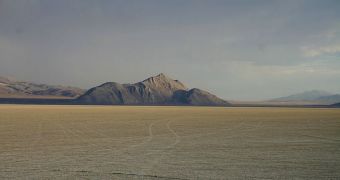A collaboration of American agencies are working together to analyze the amount of carbon being released from a dry lake bed in Railroad Valley, Nevada. The team is also concerned about how much of the dangerous greenhouse gas is emitted from the area surrounding the lake bed.
The multi-institute team conducted its research between June 17-27, and also involved experts at the Moffett Field, California-based NASA Ames Research Center (ARC). In addition to methane, the group was also interested in determining how much carbon dioxide is released from the area.
Experts named the effort the Railroad Valley Vicarious Calibration Campaign. It is a result of a fruitful collaboration between the NASA Jet Propulsion Laboratory (JPL), Pasadena, California, and the Japan Aerospace Exploration Agency (JAXA).
Its primary goal is to act as a ground-based verification system for the Japanese Greenhouse Gases Observing Satellite (GOSAT). The orbital instrument is conducting methane/CO2 measurements from Earth's orbit.
In order to ensure that the satellite always provides reliable data, experts conduct verifications campaigns every single year. The collaboration travels the land, and verifies datasets that GOSAT sent of a specific location. The results must always coincide.
In addition to JAXA, JPL and ARC, the team also includes experts from the University of Wisconsin-Madison (UWM), the Colorado State University, and Fort Collins. A total of 30 scientists meet every single year to conduct the research.
For 2011, ARC engineers contributed a series of carbon dioxide/methane measurements, collected from the ground and the air. Local sources of halophiles organisms – which live in salt-rich environment – were also identified and centralized by the team.
“We are pleased to offer these observations to our Japanese and Jet Propulsion Laboratory colleagues in support of the important task of very precisely measuring greenhouse gases from space,” explains scientist Laura Iraci.
“We look forward to continuing to support the GOSAT team and the upcoming NASA Orbiting Carbon Observatory -2 (OCO-2) mission,” adds the expert, who holds an appointment as an Earth science researcher at the ARC Atmospheric Science Branch.
“Although there is a general understanding of the natural and anthropogenic sources and sinks of carbon dioxide and methane, their fluctuations must be better quantified to better forecast and mitigate global climate change,” explains ARC space science researcher Brad Bebout.
Together with colleague Chris McKay, he was the leader of the NASA research team that participated in the international endeavor. “These measurements over the dry, salt flat will help us better measure the spatial distribution and heterogeneity of greenhouse gases,” Bebout concludes.

 14 DAY TRIAL //
14 DAY TRIAL //